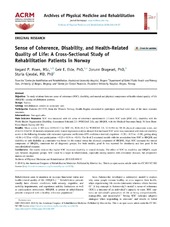| dc.contributor.author | Moen, Vegard Pihl | en_US |
| dc.contributor.author | Eide, Geir Egil | en_US |
| dc.contributor.author | Drageset, Jorunn | en_US |
| dc.contributor.author | Gjesdal, Sturla | en_US |
| dc.date.accessioned | 2019-07-01T11:26:49Z | |
| dc.date.available | 2019-07-01T11:26:49Z | |
| dc.date.issued | 2019-03 | |
| dc.Published | Moen VP, Eide GE, Drageset J, Gjesdal S. Sense of coherence, disability, and health-related quality of life: a cross-sectional study of rehabilitation patients in Norway. Archives of Physical Medicine and Rehabilitation. 2019;100(3):448-57 | eng |
| dc.identifier.issn | 0003-9993 | |
| dc.identifier.uri | https://hdl.handle.net/1956/20521 | |
| dc.description.abstract | Objective: To study relations between sense of coherence (SOC), disability, and mental and physical components of health-related quality of life (HRQOL) among rehabilitation patients. Design: Survey. Setting: Rehabilitation centers in secondary care. Participants: Patients (N=975) from the Western Norway Health Region consented to participate and had valid data of the main outcome measures. Interventions: Not applicable. Main Outcome Measures: SOC was measured with the sense of coherence questionnaire (13-item SOC scale [SOC-13]), disability with the World Health Organization Disability Assessment Schedule 2.0 (WHODAS 2.0), and HRQOL with the Medical Outcomes Study 36-Item Short-Form Health Survey (SF-36). Results: Mean scores ± SD were 62.9±12.3 for SOC-13, 30.8±16.2 for WHODAS 2.0, 32.8±9.6 for SF-36 physical component score, and 43.6±11.8 for SF-36 mental component score. Linear regression analysis showed that increased SOC score was associated with reduced disability scores in the following domains with estimated regression coefficients (95% confidence interval) cognition –0.20 (–0.32 to –0.08), getting along –0.36 (–0.52 to –0.25), and participation –0.23 (–0.36 to –0.11). The fit of 2 structural models with the association from SOC to HRQOL and disability or with disability as a mediator was better for the mental versus the physical component of HRQOL. High SOC increased the mental component of HRQOL, consistent for all diagnostic groups. For both models, good fit was reported for circulatory and less good fit for musculoskeletal diseases. Conclusions: The results indicate that higher SOC decreases disability in mental domains. The effect of SOC on disability and HRQOL might vary between diagnostic groups. SOC could be a target in rehabilitation, especially among patients with circulatory diseases, but prospective studies are needed. | en_US |
| dc.language.iso | eng | eng |
| dc.publisher | Elsevier | eng |
| dc.relation.ispartof | <a href="http://hdl.handle.net/1956/20522" target="blank"> Disability in patients entering rehabilitation centres in secondary care in Norway: A cross-sectional study of predictors and the relationships with sense of coherence and health-related quality of life</a> | |
| dc.rights | Attribution-Non Commercial-No Derivatives CC BY-NC-ND | eng |
| dc.rights.uri | http://creativecommons.org/licenses/by-nc-nd/4.0/ | eng |
| dc.title | Sense of coherence, disability, and health-related quality of life: a cross-sectional study of rehabilitation patients in Norway | en_US |
| dc.type | Peer reviewed | |
| dc.type | Journal article | |
| dc.date.updated | 2019-07-01T11:07:25Z | |
| dc.description.version | publishedVersion | en_US |
| dc.rights.holder | Copyright 2018 by the American Congress of Rehabilitation Medicine. | |
| dc.identifier.doi | https://doi.org/10.1016/j.apmr.2018.06.009 | |
| dc.identifier.cristin | 1613901 | |

